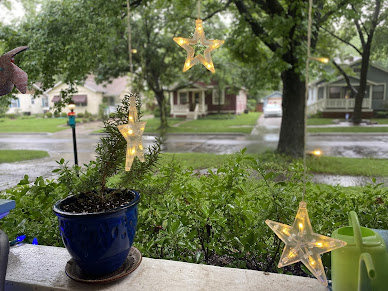Day 26: Lawrence KS to Syracuse KS
Late start
Flint Hills
Kansas like a lot of great plains states is comprised primarily of sedimentary rocks that get younger as you head west. Also like a lot of Great Plains states, it gets drier as you head west and further from the moisture sources of the Gulf. Much of the state is along "the imperceptible slope" where average elevation climbs 2500 feet over 400 miles. Depending on how close you are to a major river system this can be anything from a long flat drive to a series of rolling hills where the average climb is slightly more than the average descent.
About 1/3 of the way across the state one enters the Flint hills, the top of a broad anticline in the otherwise nearly horizontal sedimentary rocks. It exposes a rock that weathers into a fine soil for tall grasses. The elevation and views afforded here make this a popular weekend outing destination in the region. We stopped only to use the restroom and take some pics, but knew more was our there as always.
Mushroom rocks
Near Salina we left the freeways and set out on back roads that would be much of our remaining journey. Our only real stop today was a location 30 minutes WSW of Salina known as Mushroom Rocks State park. This small little patch of land, measuring less than 1/4 mile across and less than 1/2 mile from North to South preserves a number of spectacular concretions that sometimes form as part of the sandstone diagenetic process. What we see in these pictures is a sandstone with crossbedding indicating a persistent current at time of deposition. At some later time when the sandstone was well buried. The water in the pores between the grains became supersaturated with calcite. This calcite grew steadily in a spherical shape from the original seed crystal, cementing the sand grains to one another. When subsequent uplift and erosion brought this sandstone back to the surface the areas cemented by calcite were more resistant to the elements and so emerged these Mushrooms. While concretions are fairly common in sandstones, these are quite a bit more voluminous than those typically found.
Arkansas valley
We continued west. The trees grew smaller and fewer, the towns had more miles in between. The land became more and more flat. So we were heading into the drier high plains. It was only the excellent quality beef jerkey that kept us awake and aware on the miles of straight roads we covered, along with the gatehring storms. We only hit one real episode of rain, but it was enough to keep things interesting. While much of the drive was in the Arkansas river valley, we barely noticed as the sides of the valley rise almost as imperceptibly as the greater plains themselves.


























has there been a time when you had to postpone a trip due because of climate changes or does the weather doesn't stop you from exploring?
ReplyDelete